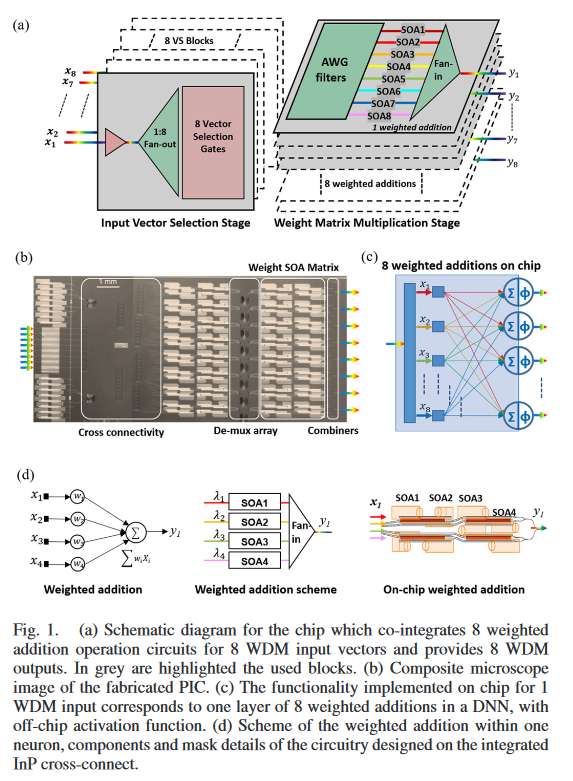Research highlight
Stabile was among the first to enter the emerging field of photonic neuromorphic computing. ‘I had been working on a proposal to build photonic digital artificial neurons when in 2017 researchers from MIT published an article describing how they developed a small chip for carrying out the same algebraic operations, but in an analog way. That is when I realized that synapses based on analog technology were the way to go running artificial intelligence, and I have been hooked on the subject ever since.’
Since then, Stabile is mainly focusing on realizing neuromorphic computing with integrated photonics technology. ‘For this exciting multidisciplinary new field, I am reusing a lot of the knowledge I gained while working on optical switching for data center applications.’ In the field of artificial intelligence, vast amounts of data need to be processed and analyzed at unprecedented speeds. ‘The algorithms you need to do this cannot be run on conventional von Neumann computing architectures. It is essential to come up with architectures in which the memory and the computation part of the computer are much closer, to ensure smooth and fast data transport between the two. There are a plethora of very promising solutions in electronics, but the dilemma there is the limited amount of data that can run through the interconnects. In photonics, you can transport almost unlimited amounts of data at the speed of light.’

Similar concepts
A human brain contains around 100 billion neurons, each of which can communicate with thousands of colleagues via synapses that carry neurotransmitters. ‘The key concepts here are the nodes and the interconnectivity. And that is quite similar to what we need in optical switching.’ That is why Stabile sees promising possibilities of using integrated photonic matrices to build neuromorphic networks. And the other way around, she also believes this entirely new field of neuromorphic photonics will leverage further advances in optical switch architectures.
‘The challenge is to scale up to large numbers of neurons. Therefore, new research questions arise: How can you stack those in two to three layers only and still end up with reliable computing results? Would it be possible to redesign algorithms in such a way that we could simplify the required network architecture? To answer these and other questions, I collaborate with many other colleagues from complementary disciplines, ranging from material science and embedded systems to mathematics and computer science. That is the most fun part of my work, the fact that I can cover the entire chain from the materials and technology side all the way up to the actual application through the full computing layer stack,’ the electrical engineer says.
Stabile sees a wealth of opportunities for this technology: in autonomous driving, in ultra-fast image classification, in long haul optical communications, or in aerospace.
Simplify first
Instead of building as complex networks as possible, Stabile first goes back to the basics. ‘At the moment I am trying to determine to what extent we can simplify the required networks and still obtain reliable predictions. What would be the killer application for these types of networks, and what requirements do they have to meet? The next step is to integrate the required physical layers, control systems, algorithms, and readouts into a working system that is able to accelerate computation in an efficient manner.’ Scaling up the technology will be the next phase. ‘We can explore ample possibilities to achieve the desired performance, ranging from nanophotonics to spintronics and plasmonics.’
In the near future, Stabile hopes to demonstrate a 3D neuron based on the integration of electronics and multi-functional photonics. ‘That could consist in the first place of an indium phosphide layer for nonlinear processes, covered with a routing layer made out of silicon nitride for ultra-low loss synaptic operations, loaded by a memory layer, for example, based on phase-changing materials. From an in-depth analysis of the metrics calculations, this can allow petascale computation at tens of femtoJoules per operation. Here in Eindhoven we have the right ecosystem, the right expertise, and the right equipment to produce such a neuron and study its properties. Also, the recently launched Eindhoven Hendrik Casimir Institute will further stimulate our research.’
Ample applications
Stabile sees a wealth of opportunities for this technology. ‘For example, in autonomous driving, where you need to process and analyze a myriad of data from a vast amount of sensors to base real-time decision making. Or in ultra-fast image classification, where you could use convolutional free-space optical neural networks to support radiologists in interpreting medical images or to allow extreme signal processing for astronomical imaging. But also in long haul optical communications, to relieve the power overhead of digital signal processing at the receive side, or in aerospace where you could use ultra-low-power photonic neural networks to pre-process the acquired data before you send them down to earth.’
But those are all dreams for the long run. At the moment, Stabile focuses on optimizing the on-chip network architecture and developing an accelerator test-bed. The test-bed can attract the interest of companies to explore how this technology could help solve their problems. And, of course, attracting new scientists and students to this emerging field of research: ‘Neuromorphic photonics is a very exciting multidisciplinary field that holds great promises for the future. At TU/e, we are at the forefront of the topic, working on technology, networks, architecture, and computer science. What’s not to like?’